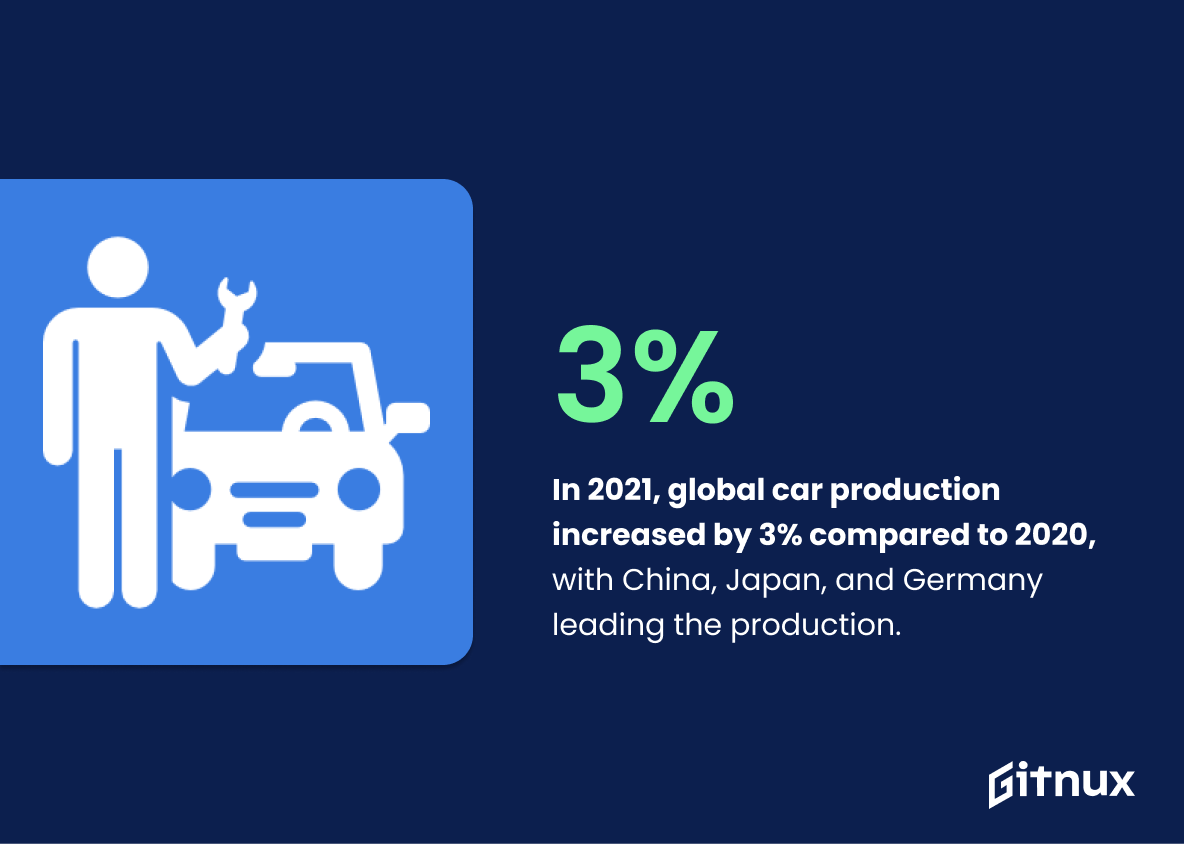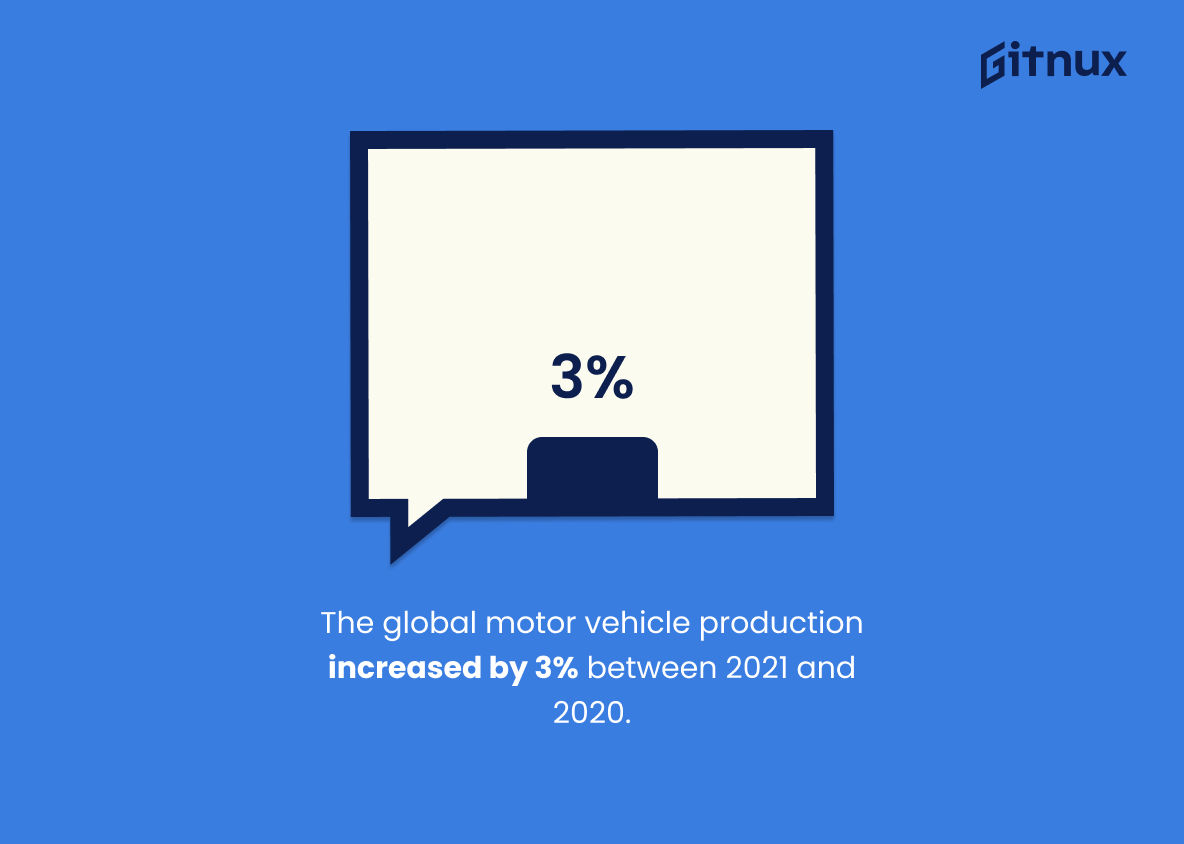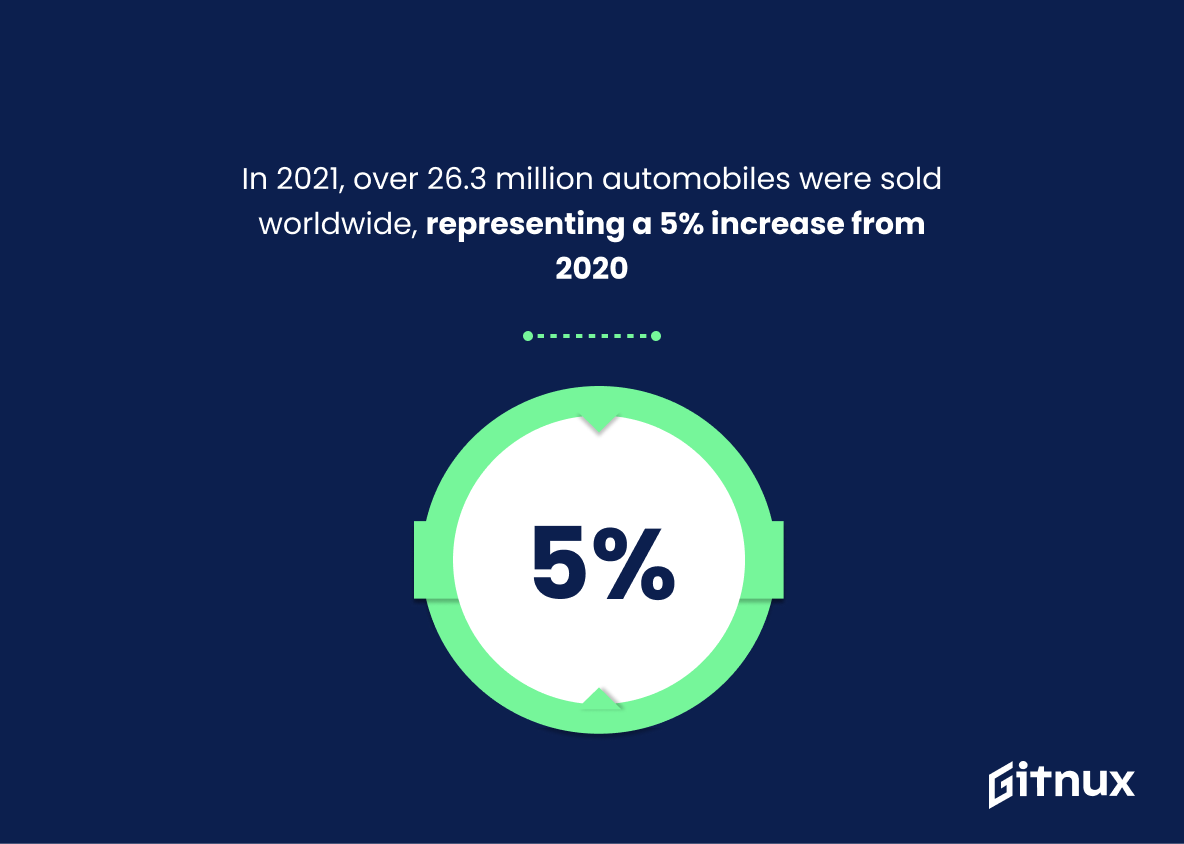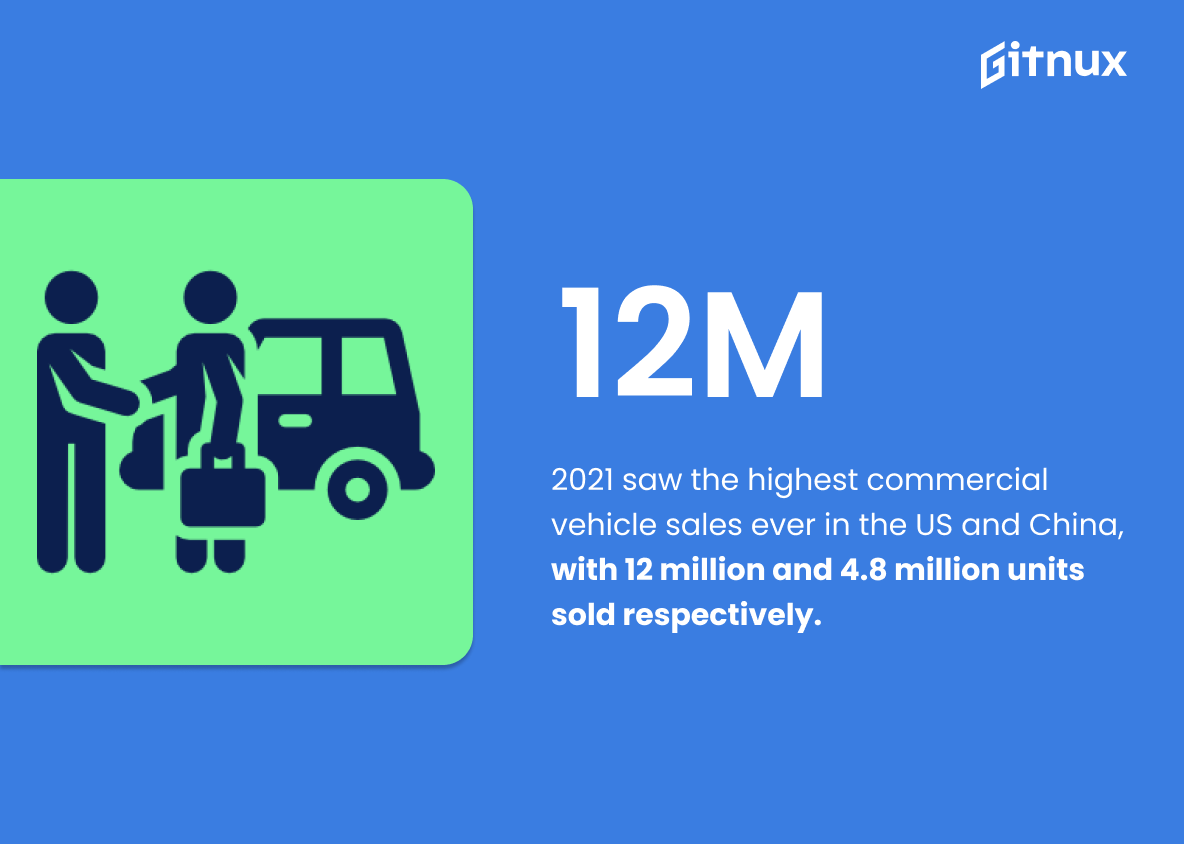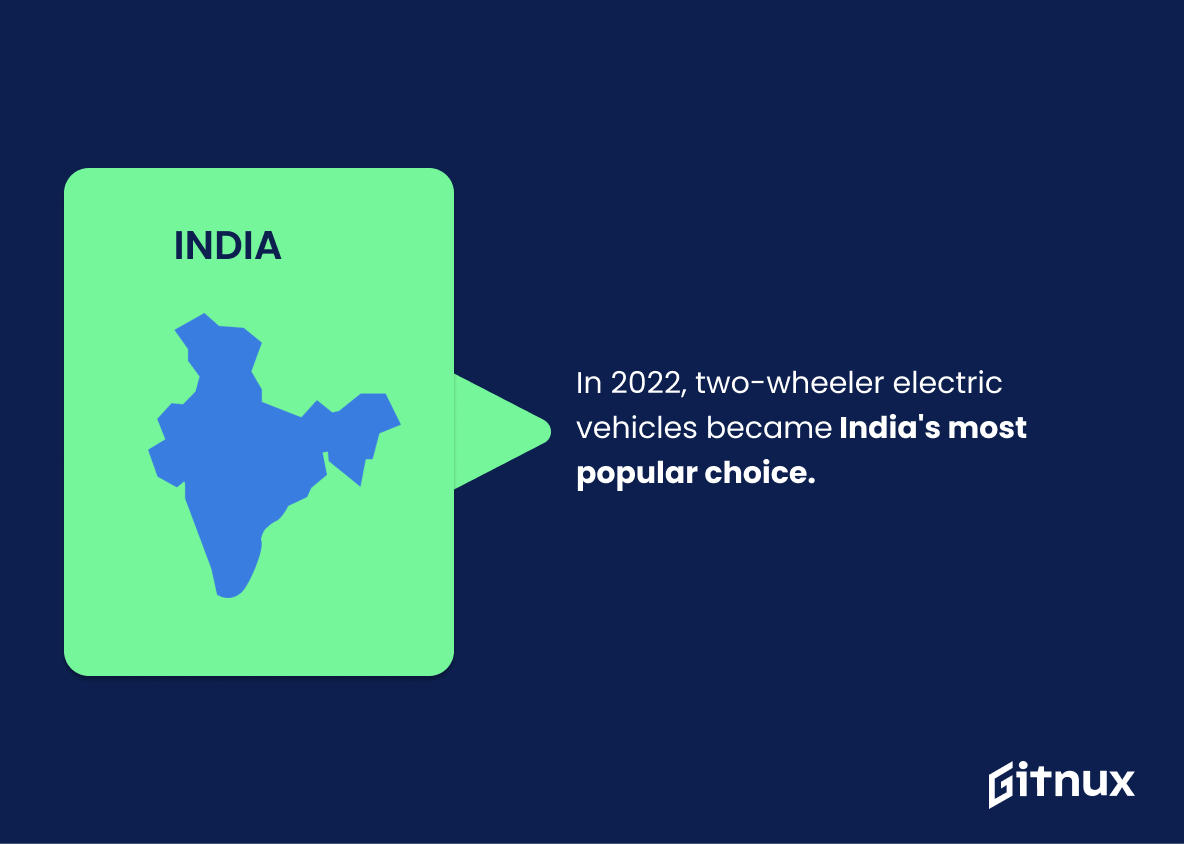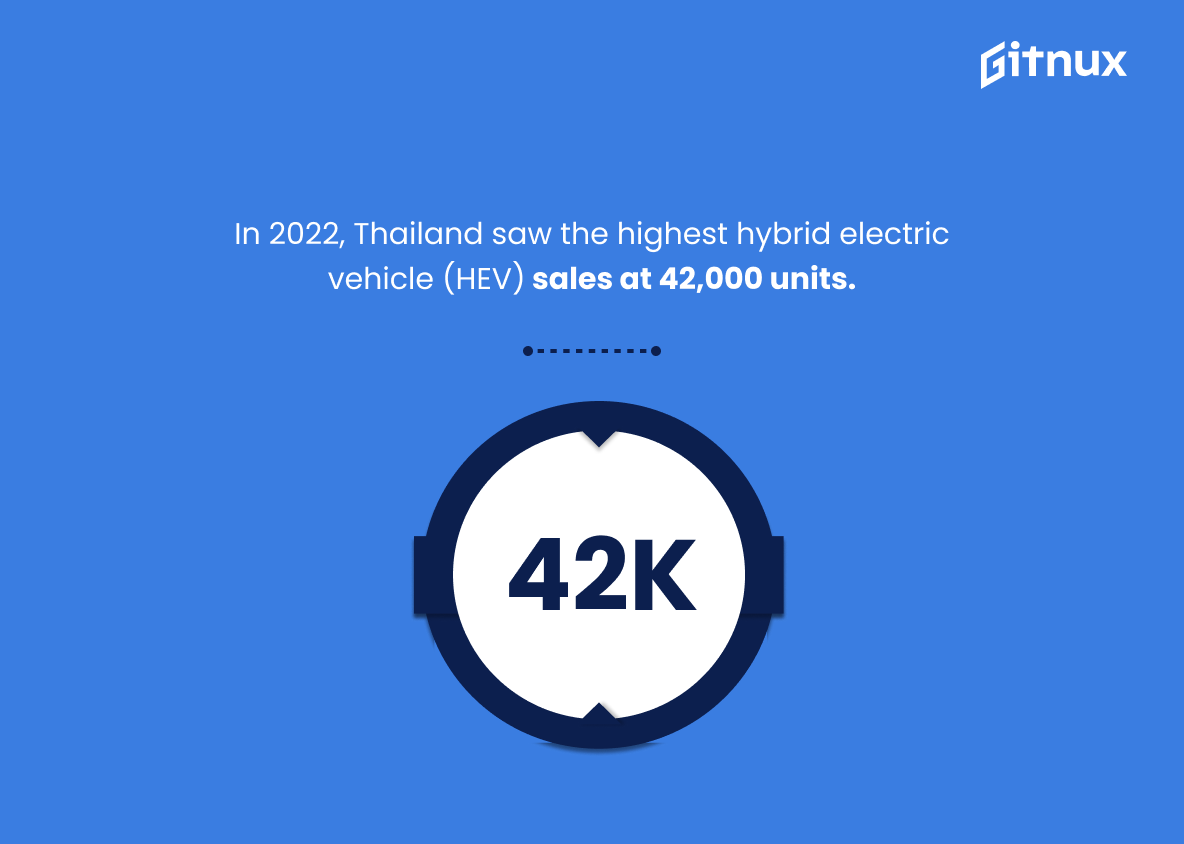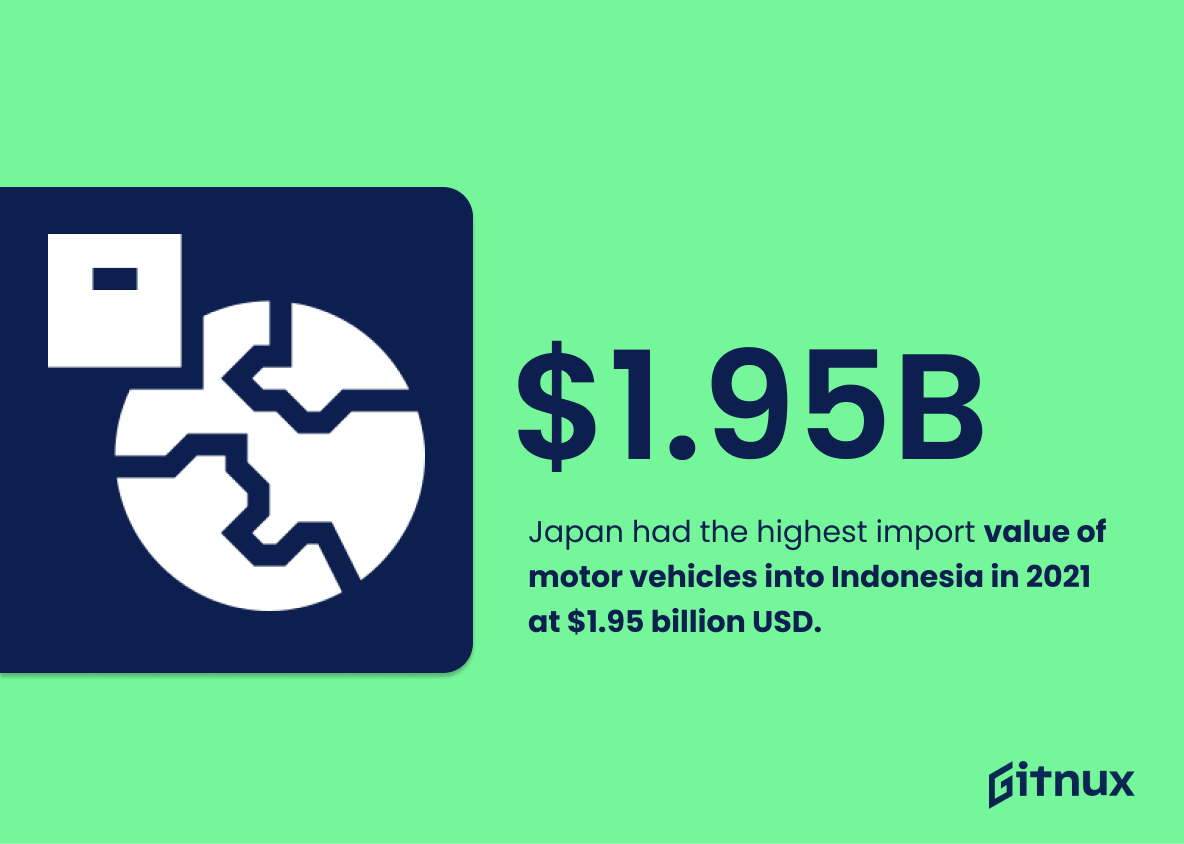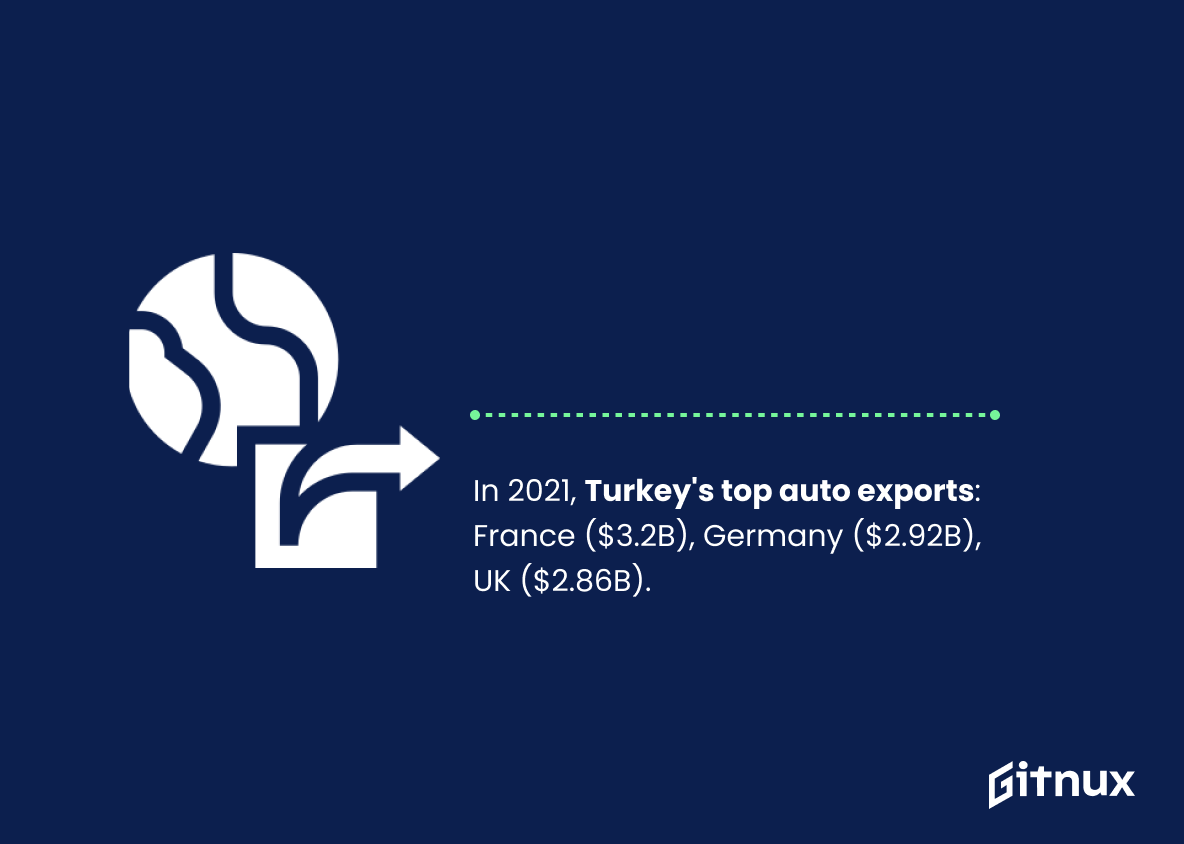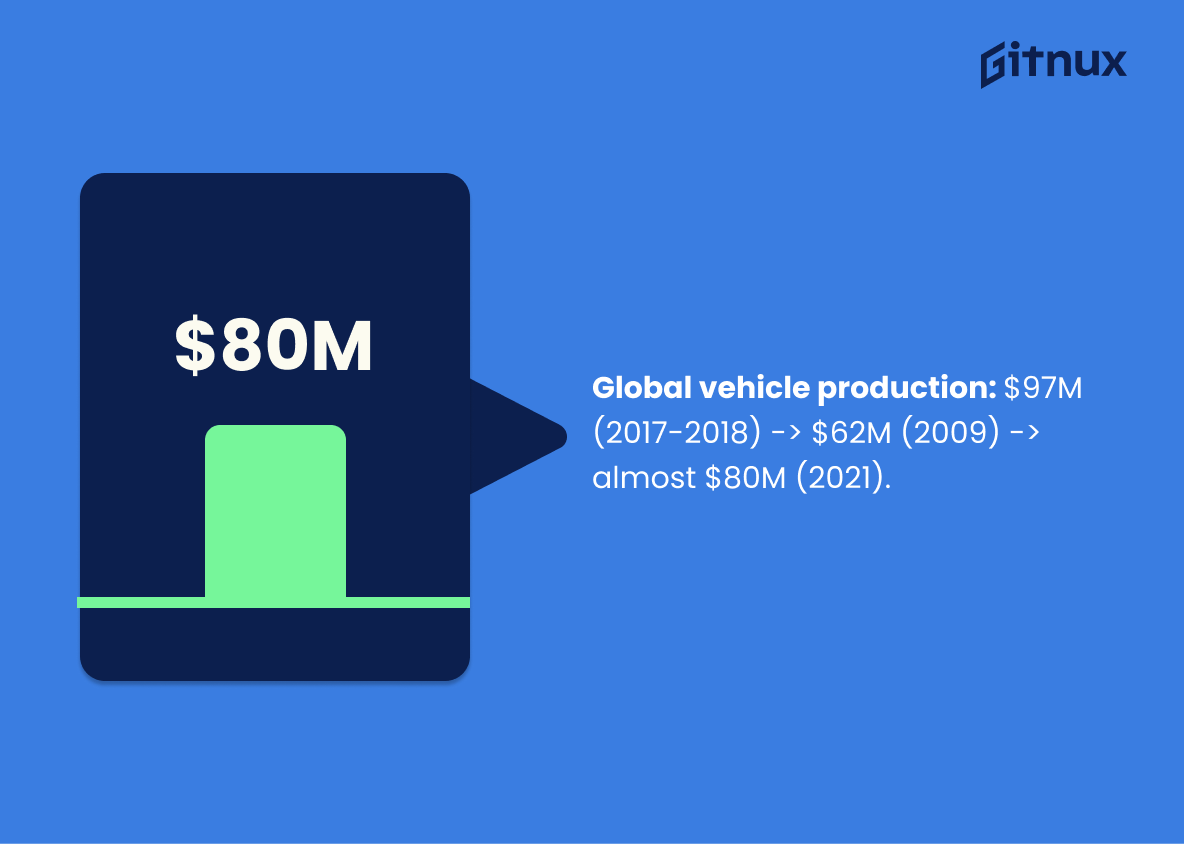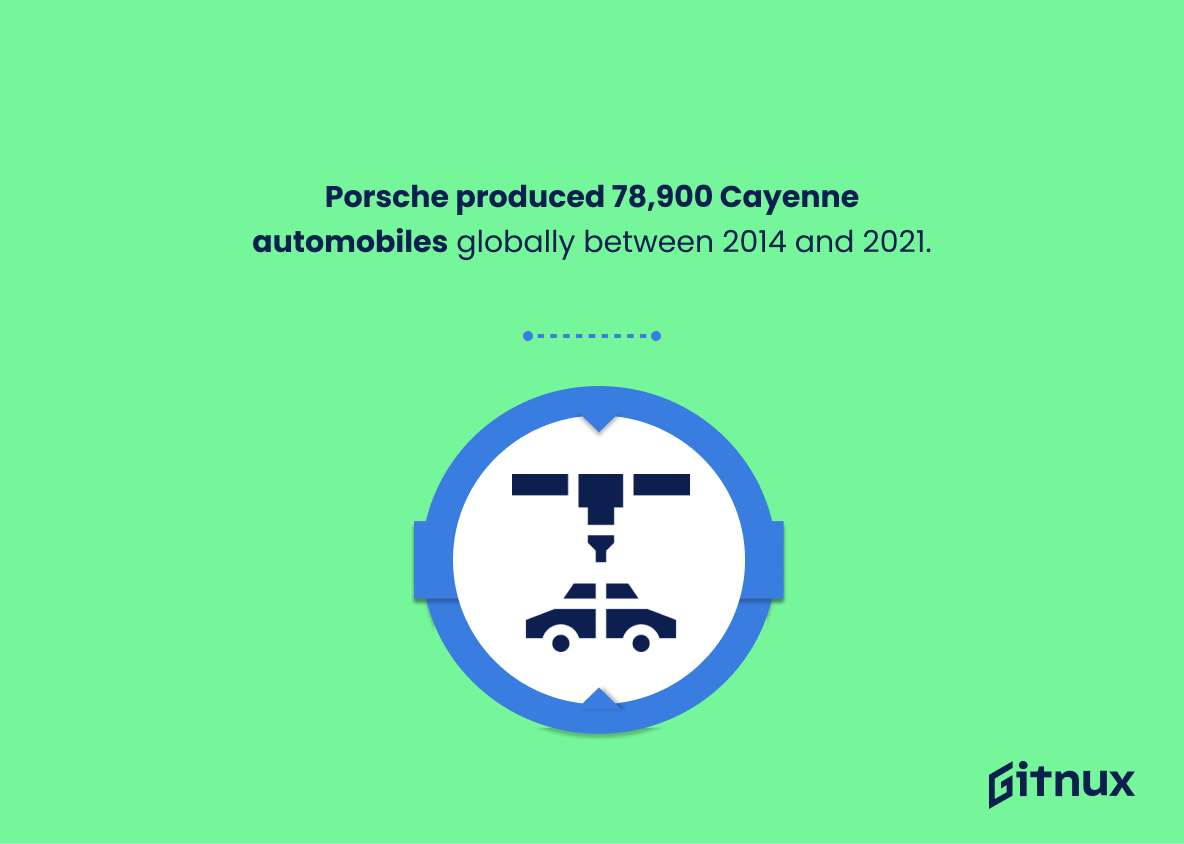The global automotive industry is an ever-evolving sector that is constantly changing and adapting to new trends and technologies. As the industry continues to grow, it is important to stay up to date on the latest automotive industry statistics.
This blog post will provide an overview of the current state of the global automotive industry, including the latest trends, market size, and sales figures. We will also discuss the impact of new technologies and regulations on the industry, as well as the potential for future growth. Finally, we will provide some useful resources for further reading on the topic.
Global Automotive Industry: The Most Important Statistics
Toyota Motor Corporation has surpassed Volkswagen Group as the largest automaker in the world with a market share of 10.5%.
Japan had the highest import value of motor vehicles into Indonesia in 2021 at $1.95 billion USD.
Global Automotive Industry Statistics Overview
In 2021, global car production increased by 3% compared to 2020, with China, Japan, and Germany leading the production.
This increase is important as it signals a recovery from the production drop due to COVID-19 in 2020, and the partnership between American General Motors and China will likely lead to further growth in the automotive industry.
The global motor vehicle production increased by 3% between 2021 and 2020, yet output was still 15% lower than pre-pandemic levels.
This highlights the need for the industry to continue to recover from the pandemic in order to reach pre-pandemic levels of production.
Toyota Motor Corporation has surpassed Volkswagen Group as the largest automaker in the world with a market share of 10.5%.
It shows that Toyota is the leading automaker in the world and is setting the standard for the industry. This could lead to increased competition among automakers to try and match Toyota’s success and could lead to more innovation and better products for consumers.
Toyota led the automotive market in the UAE with a 30.7% market share of new car sales in 2021, with the Toyota Land Cruiser being the best selling car model.
The US led the world’s luxury car markets in 2021 with 7.7 billion dollars in revenue, followed by Germany with 2.3 billion dollars and the UK with 1.7 billion dollars.
This shows the relative strength of the US economy compared to other countries in the luxury car market. It also indicates the potential for growth in the luxury car market in the US, as well as the potential for other countries to increase their share of the market.
In 2021, over 26.3 million automobiles were sold worldwide, representing a 5% increase from 2020 and a steady increasing trend since 2009.
It is important for businesses to understand this current market trends and make informed decisions about their investments in the automotive industry.
2021 saw the highest commercial vehicle sales ever in the US and China, with 12 million and 4.8 million units sold respectively.
This demonstrates the strength of the global automotive industry, particularly in the two largest markets. It also shows that despite the economic downturn caused by the pandemic, people are still buying cars, which is a sign of economic resilience.
Furthermore, it highlights the importance of the US and Chinese markets for the industry, as they account for a large portion of global sales.
The US is projected to spend 48.4 billion dollars on automotive research and development in 2022, accounting for 39% of global spending which is expected to increase by 6.8%.
This shows the significant investment the US is making in the automotive industry, particularly in the electric car sector. This investment is likely to have a positive impact on the global automotive industry, as it will lead to increased innovation and development in the sector.
Volkswagen spent the most on R&D in 2021, with costs totaling more than 6.2 percent of sales income, while Hyundai Motor had the lowest R&D intensity.
The commitment of Volkswagen to research and development is essential for staying competitive in the global automotive industry.
Two-wheeler electric vehicle sales increased significantly in 2022, making them the most popular type of electric vehicle in India.
Electric vehicles are becoming increasingly popular, especially in India, and that two-wheelers are the most popular type of electric vehicle. This could have a significant impact on the global automotive industry as more people switch to electric vehicles.
In 2022, hybrid electric vehicle (HEV) sales in Thailand reached 42,000, the highest number among all electric vehicle types.
There is an increasing interest in electric vehicles and the potential for growth in the market.
Japan had the highest import value of motor vehicles into Indonesia in 2021 at $1.95 billion USD.
This demonstrates the importance of Indonesia as a market for motor vehicles, and the influence of Japan as a major exporter of motor vehicles to Indonesia. It also provides insight into the current trends in the global automotive industry, which can help inform future decisions and strategies.
Poland’s overall imports of cars in 2021 exceeded 23 billion euros.
It shows the increasing demand for cars in Poland and the growing importance of the automotive industry in the global economy.
In 2021, France was the top destination for Turkish automobile exports, with a value of over 3.2 billion dollars, followed by Germany and the United Kingdom with export values of 2.92 and 2.86 billion dollars, respectively.
In 2021, Japan’s motor vehicle exports rose from 12.8 trillion Japanese yen to 14.71 trillion yen, the highest in the past 10 years. It exhibits that Japan is a major player in the global automotive industry, and that its exports of motor vehicles are increasing.
Global motor vehicle production decreased from 97 million in 2017-2018 to 62 million in 2009, but increased to almost 80 million in 2021.
This provides insight into the current state of the industry, which is that production is increasing again after a period of decline.
Global production of commercial vehicles fell by 13% between 2019 and 2020 before rebounding in 2021, with 80% of all commercial vehicles manufactured being light commercial vehicles.
The production of commercial vehicles are a major part of the automotive industry. It shows the impact of the pandemic on the industry, as well as the recovery of the industry in 2021.
Porsche produced 78,900 Cayenne automobiles globally between 2014 and 2021. This statistic is important because it shows the success of the Porsche Cayenne model in the global automotive industry.
Porsche produced over 38,300 911 Coupe/Cabriolets globally between 2014-2021. This statistic is important as it provides insight into the success of Porsche’s 911 model in the global automotive industry.
This highlights the overall demand for luxury vehicles and the potential for growth in the industry. Additionally, it provides a benchmark for other automakers to measure their success against.
The global automotive market is expected to grow at a compound annual growth rate (CAGR) of 3.8% from 2021 to 2028.
This is an essential piece of information for anyone interested in the automotive industry, as it can help them to make informed decisions about investments and strategies. By understanding the projected CAGR of the global automotive market, businesses can plan for the future and ensure they are well-positioned to take advantage of any opportunities that may arise.
The value of the global automotive market was approximately $8.42 trillion in 2020.
This serves as a reminder of the immense economic impact the automotive industry has on the world, and how it continues to grow and evolve. It is a powerful indicator of the industry’s potential and its importance to the global economy. This statistic is an essential piece of information for anyone looking to gain a better understanding of the automotive industry and its current state.
Electric vehicle (EV) sales made up around 4.2% of global automotive sales in 2020.
The fact that electric vehicle sales accounted for 4.2% of global automotive sales in 2020 is indicative of the growing trend towards electric vehicles. It is also a sign of the industry’s commitment to sustainability and environmental protection, as more and more people are choosing to switch to electric vehicles. This statistic is an important reminder of the progress that has been made in the automotive industry, and the potential for further growth in the future.
Automotive production declined by around 16% in 2020 due to the impact of COVID-19.
The staggering 16% decline in automotive production in 2020 serves as a stark reminder of the devastating effects of COVID-19 on the global automotive industry. This statistic is a powerful illustration of the immense disruption caused by the pandemic, and serves as a reminder of the importance of understanding the current state of the automotive industry.
It is essential to be aware of the impact of the pandemic on the automotive industry in order to make informed decisions about the future of the industry. This statistic is an important part of the global automotive industry statistics, and should be taken into account when discussing the industry’s current state.
China was the largest automotive market in 2020, with nearly 26 million vehicles sold.
The fact that China was the largest automotive market in 2020, with nearly 26 million vehicles sold, is a testament to the immense potential of the global automotive industry. It is a reminder that the automotive industry is a major contributor to the global economy, and that it is an industry that is constantly evolving and growing.
It is predicted that by 2025, about 27% of global light vehicle production will be electric.
By 2025, nearly a third of light vehicle production is expected to be electric, demonstrating the industry’s commitment to transitioning to more sustainable and environmentally friendly vehicles. This shift in production is sure to have a significant impact on the automotive industry, and it is important to be aware of the changes that are taking place.
The share of autonomous vehicles in new vehicle sales is expected to reach 5% by 2030.
By 2030, the number of autonomous vehicles on the roads is expected to increase significantly, indicating a shift in the industry towards more advanced technology. This statistic is important for understanding the direction of the automotive industry and the potential impact of autonomous vehicles on the global economy.
The global automotive aftermarket was valued at $378.4 billion in 2020.
This serves as a reminder of the immense economic impact the automotive industry has on the global economy, and the importance of staying up-to-date on the latest industry trends and developments.
The automotive sensors market is expected to reach $42.96 billion by 2026, with a CAGR of 6.7%.
It is set to experience significant growth in the coming years. This is an important indicator for the global automotive industry, as it suggests that the industry is likely to benefit from the increasing demand for automotive sensors. Furthermore, the CAGR of 6.7% indicates that the market is likely to experience steady growth over the forecast period, providing a strong foundation for the industry to build upon.
The global automotive composites market is projected to grow at a CAGR of 7.6% from 2021 to 2028.
This information is essential for businesses in the automotive industry, as it can help them plan their strategies and investments accordingly. Additionally, it can also provide insight into the potential opportunities and challenges that may arise in the future.
Approximately 14.5 million passenger cars were produced globally in 2020.
Despite the economic downturn caused by the pandemic, the industry was still able to produce a significant number of cars. This is a testament to the resilience of the automotive industry and its ability to adapt to changing circumstances.
The automotive software market is expected to reach $10.7 billion in 2025, growing at a CAGR of 18% from 2021 to 2025.
The industry is expected to experience a significant growth in the coming years, with a CAGR of 18% from 2021 to 2025. This is an important indicator of the industry’s future prospects and provides valuable insight into the global automotive industry.
The global automotive industry is projected to create about 717,000 new jobs by 2025.
With 717,000 new jobs projected to be created by 2025, the global automotive industry is a promising field for those seeking employment. This statistic is a testament to the industry’s growth and potential, and is a great reminder of the opportunities available to those interested in the automotive industry.
By 2030, India’s automotive industry is predicted to be the third-largest in the world, after China and the US.
It is on track to become a major player in the global automotive market. It is a sign of the country’s economic growth and its ability to compete with the world’s leading automotive markets. This statistic is an important indicator of the future of the global automotive industry, and is essential for understanding the current and future trends in the industry.
In 2021, the global automotive industry’s research and development investment is estimated at $134 billion.
This speaks to the industry’s commitment to innovation and its dedication to staying ahead of the curve. This investment is essential for the industry to remain competitive and to continue to provide the latest and greatest in automotive technology.
It is also indicative of the industry’s commitment to safety and sustainability, as research and development is key to developing new technologies that can help reduce emissions and improve safety. This statistic is a powerful reminder of the importance of the automotive industry and its impact on the global economy.
About 91.2 million vehicles were sold worldwide in 2019.
The industry is a major player in the global economy, with 91.2 million vehicles sold in 2019 alone. This statistic is a powerful indicator of the industry’s success and its potential for continued growth.
The global demand for automotive lightweight materials is expected to reach $262.8 billion by 2027, growing at a CAGR of 7.4%.
The demand for lightweight materials is expected to increase significantly over the next few years, indicating that the automotive industry is likely to experience a period of rapid expansion. This could have a major impact on the global economy, as the automotive industry is a major contributor to economic growth. As such, this statistic is an important piece of information for anyone interested in the global automotive industry.
By 2030, the revenue potential for automotive OEMs from connected services is anticipated to be $155 billion.
The automotive OEMs are set to benefit from a massive influx of revenue from connected services, which could revolutionize the industry. This statistic is a clear sign that the automotive industry is on the brink of a major transformation, and it is essential for readers of the blog post to be aware of this.
The global automotive cybersecurity market size is projected to grow at a CAGR of 23.2% from 2021 to 2028.
As the industry continues to expand, the need for secure systems and networks to protect vehicles from cyber threats is becoming increasingly essential. The projected CAGR of 23.2% indicates that the automotive cybersecurity market is expected to experience significant growth in the coming years, making it a key factor in the success of the global automotive industry.
In 2021, global investments in digital engagement platforms for the automotive industry reached $27.8 billion.
The industry is investing heavily in digital engagement platforms, indicating that it is taking advantage of the opportunities presented by the digital revolution. This is an important indicator of the industry’s commitment to staying ahead of the curve and staying competitive in the global market.
Conclusion
The global automotive industry is a major contributor to the world economy and is expected to continue to grow in the coming years. With the increasing demand for vehicles, the industry is expected to remain a major driver of economic growth.
The industry is also expected to continue to innovate and develop new technologies to meet the changing needs of consumers. As the industry continues to evolve, it is important to stay up-to-date with the latest industry statistics to ensure that businesses remain competitive and profitable.
References
1 – https://www.statista.com/statistics/262747/worldwide-automobile-production-since-2000/
2 – https://docs.google.com/spreadsheets/d/1uKdYsUmpKG-7muC8DDElGQnzoQVlSJw012jfeodbZAc/edit#gid=0
3 – https://www.statista.com/statistics/316786/global-market-share-of-the-leading-automakers/
4 – https://www.statista.com/statistics/673325/uae-car-sales-market-share-by-brand/?locale=en
5 – https://www.statista.com/forecasts/1273794/global-revenue-luxury-car-market-country?locale=en
6 – https://www.statista.com/statistics/265902/worldwide-commercial-vehicle-sales/
7 – https://www.statista.com/statistics/265936/commercial-vehicle-sales-in-selected-countries/
8 – https://www.statista.com/statistics/1345699/global-automotive-research-and-development-spending/
9 – https://www.statista.com/statistics/1306984/randd-in-selected-global-automotive-oems-expenses-and-intensity/
10 – https://www.statista.com/statistics/1234761/india-electric-vehicle-sales-by-type/
11 – https://www.statista.com/statistics/1020875/thailand-electric-vehicle-sales-volume-by-type/
12 – https://www.statista.com/statistics/680818/motor-vehicle-import-value-indonesia/
13 – https://www.statista.com/statistics/952708/poland-import-value-of-vehicles/
14 – https://www.statista.com/statistics/1368858/turkey-export-value-of-vehicles-by-country/
15 – https://www.statista.com/statistics/677391/japan-motor-vehicle-export-value/
16 – https://www.statista.com/statistics/262747/worldwide-automobile-production-since-2000/?locale=en
17 – https://www.statista.com/statistics/1095333/commercial-vehicle-production-worldwide/?locale=en
18 – https://www.statista.com/statistics/462880/worldwide-vehicle-production-of-porsche-cayenne/
19 – https://www.statista.com/statistics/462908/worldwide-vehicle-production-of-porsche-911-coupe-cabriolet/
20 – https://www.oica.net
21 – https://www.marketwatch.com
22 – https://www.statista.com
23 – https://www.pwc.com
24 – https://www.mckinsey.com
25 – https://www.marketintelligencedata.com
26 – https://www.grandviewresearch.com
27 – https://www.cnbc.com
28 – https://www.www2.deloitte.com
29 – https://www.bcg.com
30 – https://www.iea.org
31 – https://www.about.bnef.com
32 – https://www.accenture.com
33- https://www.reportlinker.com
34 – https://www.fortunebusinessinsights.com
35 – https://www.prnewswire.com
